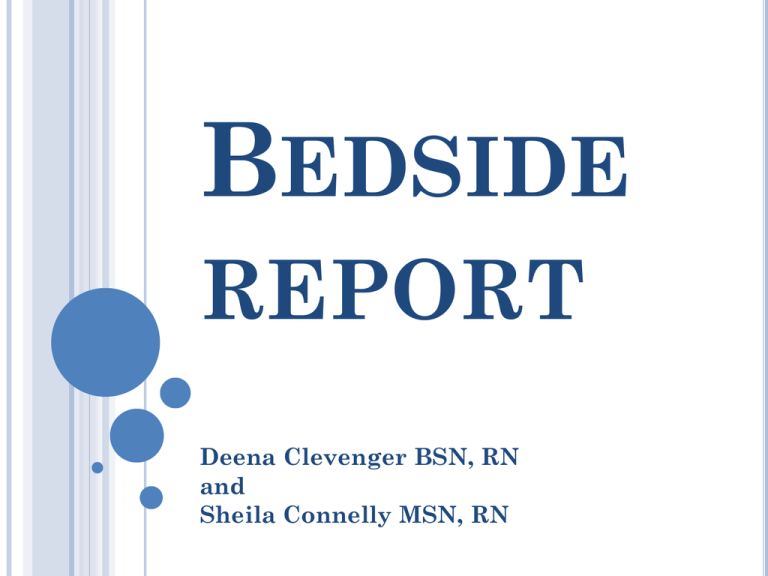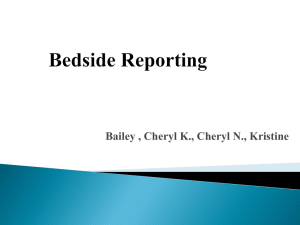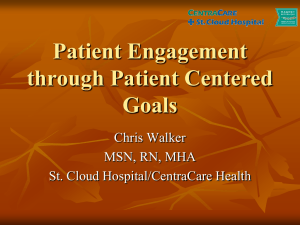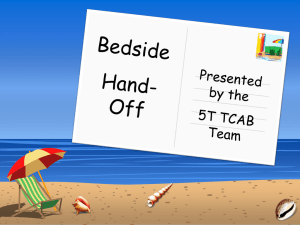Bedside Report - A process Change
advertisement

BEDSIDE REPORT Deena Clevenger BSN, RN and Sheila Connelly MSN, RN TOP REASONS FOR BEDSIDE REPORT Patient safety Patient satisfaction Builds teamwork, ownership, and accountability Allows mentoring for new nurses (Baker & McGowan, 2010) Jean Watson Nursing Theory o Carative #3 Cultivation of sensitivity to one’s self and to others • The nurses promote health and higher level functioning only when they form person to person relationships. o Carative #4 Establishing a helpingtrust relationship • Communication includes verbal, nonverbal, and listening in a manner which connotes empathetic understanding. •http://currentnursing.com/nursing_theory/Watson.com Jean Watson Nursing Theory cont. o Carative #7 Promotion of Interpersonal teaching-learning • Understanding the person’s perception of the situation assist the nurse to prepare a cognitive plan. o Carative #8 Provision for a supportive, protective, and /or corrective mental, physical, socio-cultural and spiritual environment • Nurse must provide comfort privacy, and safety for the patient. •http://currentnursing.com/nursing_theory/Watson.com PATIENT SAFETY According to Baker & McGowan, “Bedside shift report decreases the potential for near misses through a transfer of responsibility and trust by using standardized communication” (2010, p 357). Improves “patient safety by incorporated safety checks into report, such as ensuring there is a suction machine at the bedside and noting allergy alerts” (Trossman, 2009, p 7). PATIENT SATISFACTION “Reassures patients that the nursing staff works as a team, and patients witness a safe, professional transfer of responsibilities” (Laws & Amato, 2010, p 71). Patients feel more empowered. Patients are more involved. Patient becomes an additional resource in diagnosis and treatment (Caruso, 2007). 3 OF THE JOINT COMMISSION’S NATIONAL PATIENT SAFETY GOALS ARE UPHELD 1. “Improve the accuracy of patient identification.” -Checking armbands during report and asking for two patient identifiers. 2. “Improve the effectiveness of communication among caregivers: managing hand-off communications.” 3. “Encourage patients’ active involvement in their own care as a patient safety strategy.” (Joint Commission Perspectives, 2008) BENEFITS FOR THE NURSING STAFF Oncoming nurse can visualize patients immediately and prioritize care for the shift. Prepares RN to answer MD questions. Accountability between shifts is promoted. Improves the relationships of staff between shifts and builds a “teamwork” environment. ( Anderson & Mangino, 2006) CHALLENGES Letting go and allowing change Fear that report will take longer Confidentiality and privacy Cynicism and pessimism Lack of a shared vision TIPS FOR SUCCESS “Be sensitive to privacy and information shared in front of patient. Discuss sensitive information away from patients bedside.” Educate the incoming nurses about how to give report. Exclude opinions and stories, report is a time for facts. Avoid putting a nurse on the spot in front of patient and/or family. (Baker & McGowan, 2010, p 358) Informative More individualized Bedside report Involves the Patient Shorter CHARGE NURSE ON THE PREVIOUS SHIFT oProvides for the on coming shift a one page report sheet showing: Palliative care patients • DNR’s • Isolation patients: MRSA, VRE, pseudomonas, etc • Possible discharges • • • • • • Close observation One to one patients 24 hour urine Wound vac’s Anything else that constitutes extra time for care PICO QUESTION Does the use of a standardized bedside report versus taped report help increase patient satisfaction and decrease nursing overtime usage at the Veterans Healthcare Systems of the Ozarks (VHSO)? Approval from management as well as U of A professors to begin pilot study. Discussion at both Evidenced Based Practice Committee and Shared Governance Committee April 1st, 2012 Bedside Report began at VHSO! DESIGN Before-after experimental design used. Independent variable is the method of communication (taped report versus verbal at bedside) 2 Dependent Variables 1. Patient Satisfaction 2. RN Overtime Usage DESIGN Patient Satisfaction Measured by Survey of Healthcare Experiences of Patients (SHEP) data. Data gathered pre and post initiation of bedside report. RN Overtime Usage Overtime use included the time during change of shift overlap. May include up to 1-2 hours over. Does not include the extra 4- 8 hour shifts that nurses agree to work. DESIGN Two acute care nursing units were included in the study (2A and 2B). Both units were performing taped report prior to the study. Starting April 1st, both units transitioned to bedside report. A standardized communication tool was developed and distributed prior to the initiation of bedside report. Education was given to all RN/LPN staff members prior to initiation of study via staff meetings and poster presentations. OUTCOME MEASUREMENT COLLECTION Sample population Veteran patients hospitalized at VHSO (inpatient setting), Fayetteville, AR. Inclusion criteria Veterans who respond to the SHEP survey post discharge. DATA COLLECTION PLAN SHEP surveys are mailed to patients post discharge. Questionnaire includes a total of 53 questions. It takes an estimated 15 minutes to complete the survey. We selected 6 total questions directly related to nursing care to include in this study. In addition to SHEP survey results, we will discuss RN overtime usage results….. DAY SHIFT RN OVERTIME USAGE 25 20 H 15 O U R 10 S 2A 2B 5 0 January February March EVENING SHIFT RN OVERTIME USAGE 6 5 H 4 O U 3 R S 2 2A 2B 1 0 January February March NIGHT SHIFT RN OVERTIME USAGE 4 3.5 3 H 2.5 O U 2 R S 1.5 2A 2B 1 0.5 0 January February March SHEP DATA DURING YOUR HOSPITAL STAY, HOW OFTEN DID NURSES TREAT YOU WITH COURTESY AND RESPECT? 100 90 80 70 60 50 N 40 Weighted % 30 20 10 0 Always Usually Sometimes Never SHEP DATA DURING THIS HOSPITAL STAY, HOW OFTEN DID NURSES LISTEN CAREFULLY TO YOU? 70 60 50 40 N 30 Weighted % 20 10 0 Always Usually Sometimes Never SHEP DATA DURING THIS HOSPITAL STAY, HOW OFTEN DID NURSES EXPLAIN THINGS IN A WAY YOU COULD UNDERSTAND? 80 70 60 50 N 40 Weighted % 30 20 10 0 Always Usually Sometimes Never SHEP DATA DURING THIS HOSPITAL STAY, HOW OFTEN WAS PERSONAL INFORMATION ABOUT YOU TREATED IN A CONFIDENTIAL MANNER? 90 80 70 60 50 N 40 Weighted % 30 20 10 0 Always Usually Sometimes Never SHEP DATA DURING THIS HOSPITAL STAY, HOW OFTEN DID NURSES SHOW RESPECT FOR WHAT YOU HAD TO SAY? 80 70 60 50 N 40 Weighted % 30 20 10 0 Always Usually Sometimes Never SHEP DATA DURING THIS HOSPITAL STAY, HOW OFTEN DID YOU FEEL NURSES REALLY CARED ABOUT YOU AS A PERSON? 80 70 60 50 N 40 Weighted % 30 20 10 0 Always Usually Sometimes Never CONCLUSION RN Overtime Usage will continue to be collected over the next 3 months SHEP data will be reviewed and collected on the next SHEP report, which will include 3 months of data. Input from the nursing staff on 2A/2B wards will be unofficially collected at staff meetings regarding their satisfaction with the process. REFERENCES Anderson, C., & Mangino, R. (2006). Nurse shift report: Who says you can't talk in front of the patient? Nursing Administration Quarterly, 30(2), 112-122. Baker, S. J., & McGowan, N. (2010). Bedside shift report improves patient safety and nurse accountability. Evidence-Based Practice, 36(4), 355-358). Caruso, E. M. (2007). The Evolution of Nurse-to-Nurse Bedside Report on a Medical-Surgical Cardiology Unit. MEDSURG Nursing, 16(1), 17-22. Laws, D., & Amato, S. (2010). Incorporating bedside reporting into change-of-shift report. Rehabilitation Nursing, 36(2), 70-74. The Joint Commission. (2008). Joint Commission 2009 National Patient Safety Goals. Joint Commission Perspectives, 28(7), 12-14 Tressman, S. (2009). Shifting to the bedside for report. The American Nurse, 41(2), 7. http://currentnursing.com/nursing_theory/Watson.com











